University Healthcare Safety: Human Factors and Patient Outcomes
VerifiedAdded on 2020/03/16
|13
|2952
|48
Report
AI Summary
This report delves into the critical role of human factors in healthcare, exploring their impact on patient safety and quality within a hospital setting. It identifies key human factors such as cognitive abilities, ergonomics, and interpersonal skills, and analyzes how these elements influence staff performance and contribute to potential errors. The report examines the interplay between human factors and patient safety, emphasizing the importance of a supportive work culture, effective communication, and standardized care processes. A case study illustrates how human factors can lead to adverse patient outcomes. Furthermore, the report discusses the impact of safety and risk management cultures on healthcare, including the role of national standards and organizational systems in improving patient safety. It concludes by highlighting strategies for improving organizational systems and processes, such as the Systems Engineering Initiative for Patient Safety (SEIPS) model, to enhance the overall quality and effectiveness of healthcare delivery.
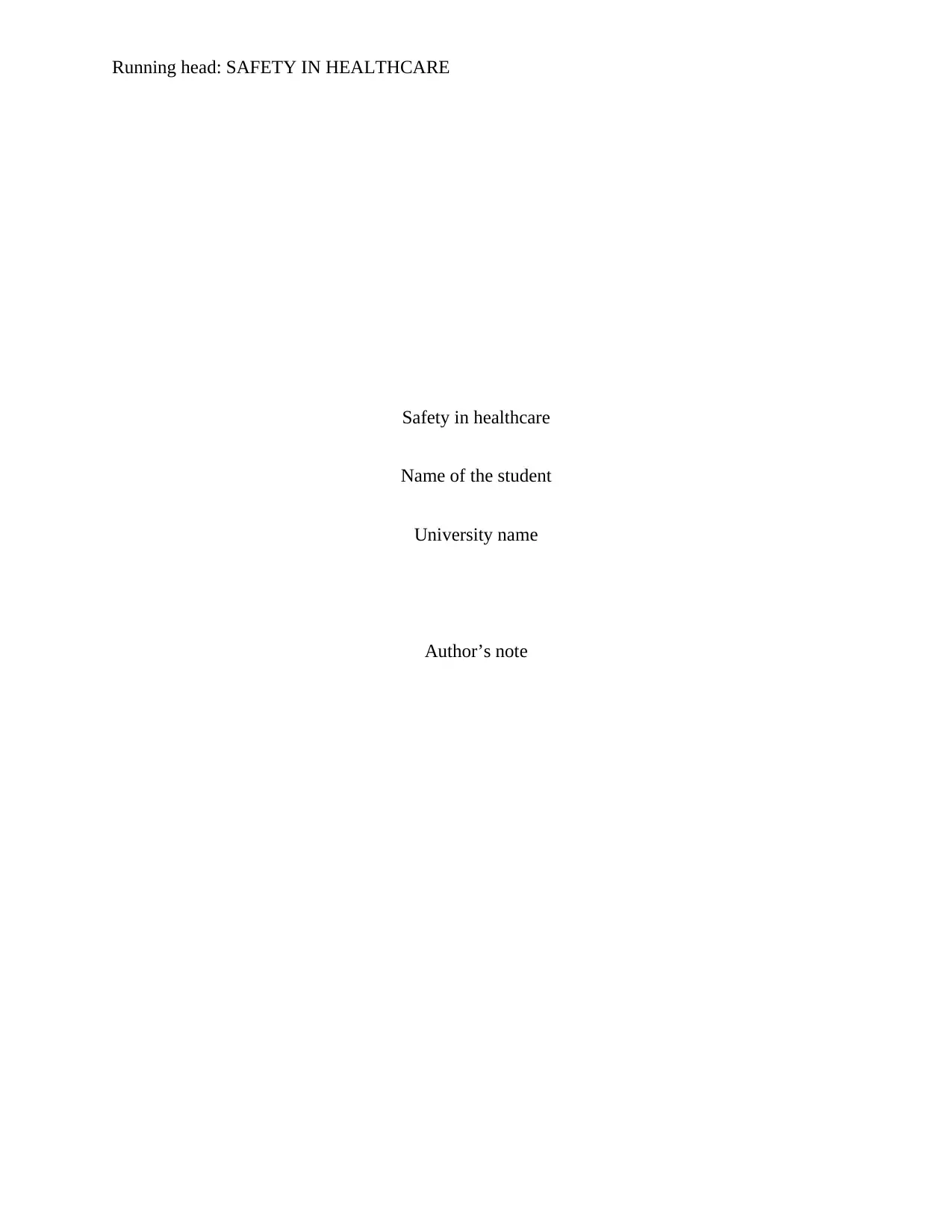
Running head: SAFETY IN HEALTHCARE
Safety in healthcare
Name of the student
University name
Author’s note
Safety in healthcare
Name of the student
University name
Author’s note
Paraphrase This Document
Need a fresh take? Get an instant paraphrase of this document with our AI Paraphraser
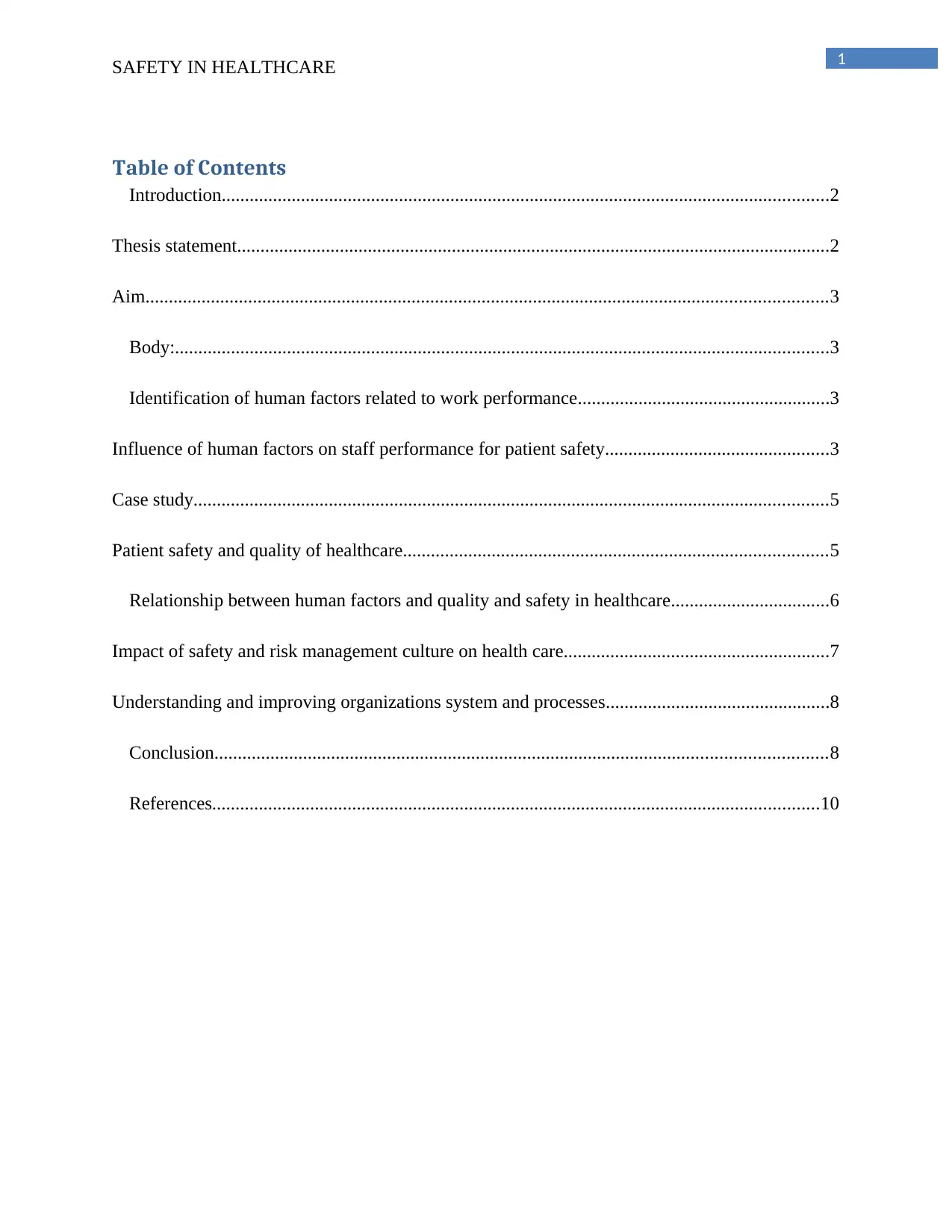
1SAFETY IN HEALTHCARE
Table of Contents
Introduction..................................................................................................................................2
Thesis statement...............................................................................................................................2
Aim..................................................................................................................................................3
Body:............................................................................................................................................3
Identification of human factors related to work performance......................................................3
Influence of human factors on staff performance for patient safety................................................3
Case study........................................................................................................................................5
Patient safety and quality of healthcare...........................................................................................5
Relationship between human factors and quality and safety in healthcare..................................6
Impact of safety and risk management culture on health care.........................................................7
Understanding and improving organizations system and processes................................................8
Conclusion...................................................................................................................................8
References..................................................................................................................................10
Table of Contents
Introduction..................................................................................................................................2
Thesis statement...............................................................................................................................2
Aim..................................................................................................................................................3
Body:............................................................................................................................................3
Identification of human factors related to work performance......................................................3
Influence of human factors on staff performance for patient safety................................................3
Case study........................................................................................................................................5
Patient safety and quality of healthcare...........................................................................................5
Relationship between human factors and quality and safety in healthcare..................................6
Impact of safety and risk management culture on health care.........................................................7
Understanding and improving organizations system and processes................................................8
Conclusion...................................................................................................................................8
References..................................................................................................................................10
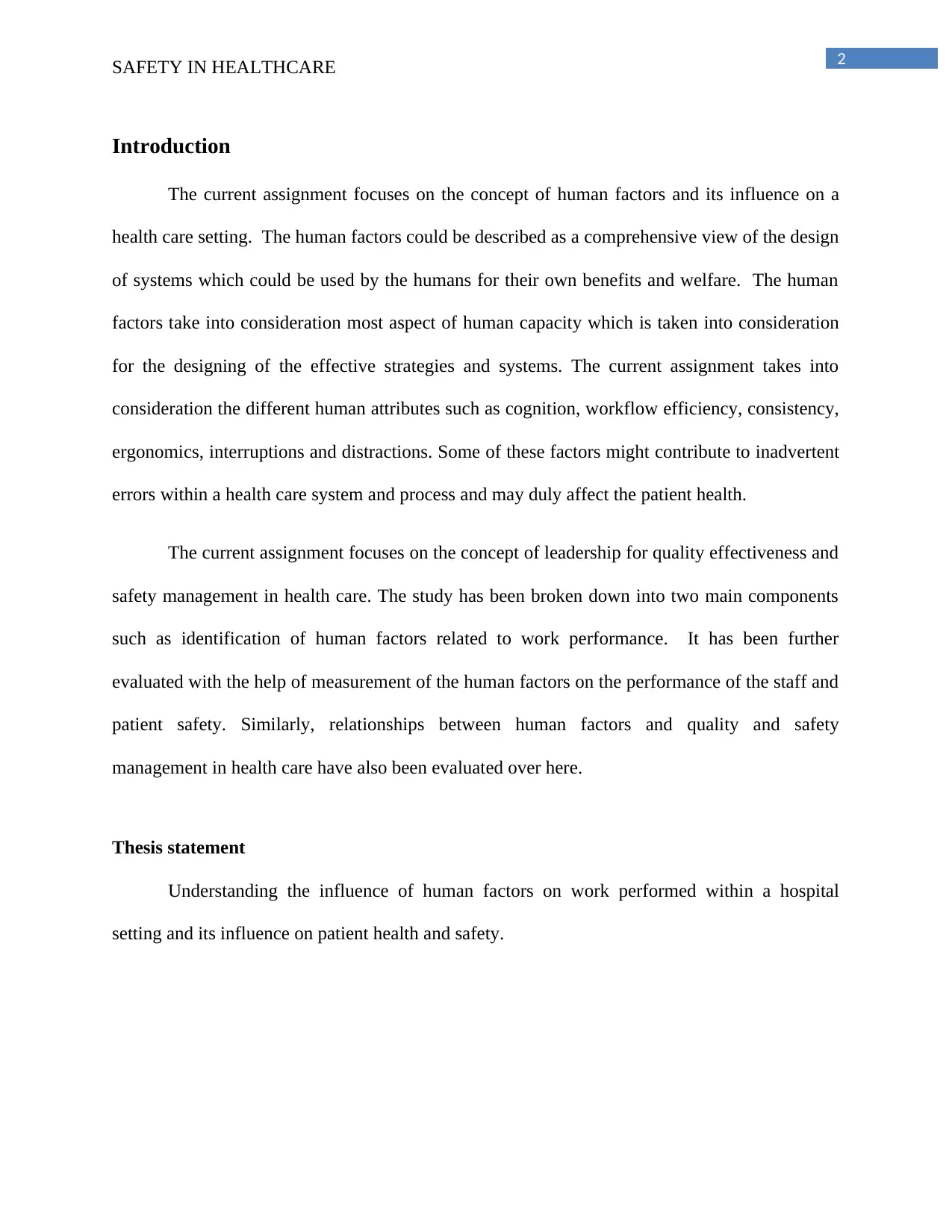
2SAFETY IN HEALTHCARE
Introduction
The current assignment focuses on the concept of human factors and its influence on a
health care setting. The human factors could be described as a comprehensive view of the design
of systems which could be used by the humans for their own benefits and welfare. The human
factors take into consideration most aspect of human capacity which is taken into consideration
for the designing of the effective strategies and systems. The current assignment takes into
consideration the different human attributes such as cognition, workflow efficiency, consistency,
ergonomics, interruptions and distractions. Some of these factors might contribute to inadvertent
errors within a health care system and process and may duly affect the patient health.
The current assignment focuses on the concept of leadership for quality effectiveness and
safety management in health care. The study has been broken down into two main components
such as identification of human factors related to work performance. It has been further
evaluated with the help of measurement of the human factors on the performance of the staff and
patient safety. Similarly, relationships between human factors and quality and safety
management in health care have also been evaluated over here.
Thesis statement
Understanding the influence of human factors on work performed within a hospital
setting and its influence on patient health and safety.
Introduction
The current assignment focuses on the concept of human factors and its influence on a
health care setting. The human factors could be described as a comprehensive view of the design
of systems which could be used by the humans for their own benefits and welfare. The human
factors take into consideration most aspect of human capacity which is taken into consideration
for the designing of the effective strategies and systems. The current assignment takes into
consideration the different human attributes such as cognition, workflow efficiency, consistency,
ergonomics, interruptions and distractions. Some of these factors might contribute to inadvertent
errors within a health care system and process and may duly affect the patient health.
The current assignment focuses on the concept of leadership for quality effectiveness and
safety management in health care. The study has been broken down into two main components
such as identification of human factors related to work performance. It has been further
evaluated with the help of measurement of the human factors on the performance of the staff and
patient safety. Similarly, relationships between human factors and quality and safety
management in health care have also been evaluated over here.
Thesis statement
Understanding the influence of human factors on work performed within a hospital
setting and its influence on patient health and safety.
⊘ This is a preview!⊘
Do you want full access?
Subscribe today to unlock all pages.

Trusted by 1+ million students worldwide
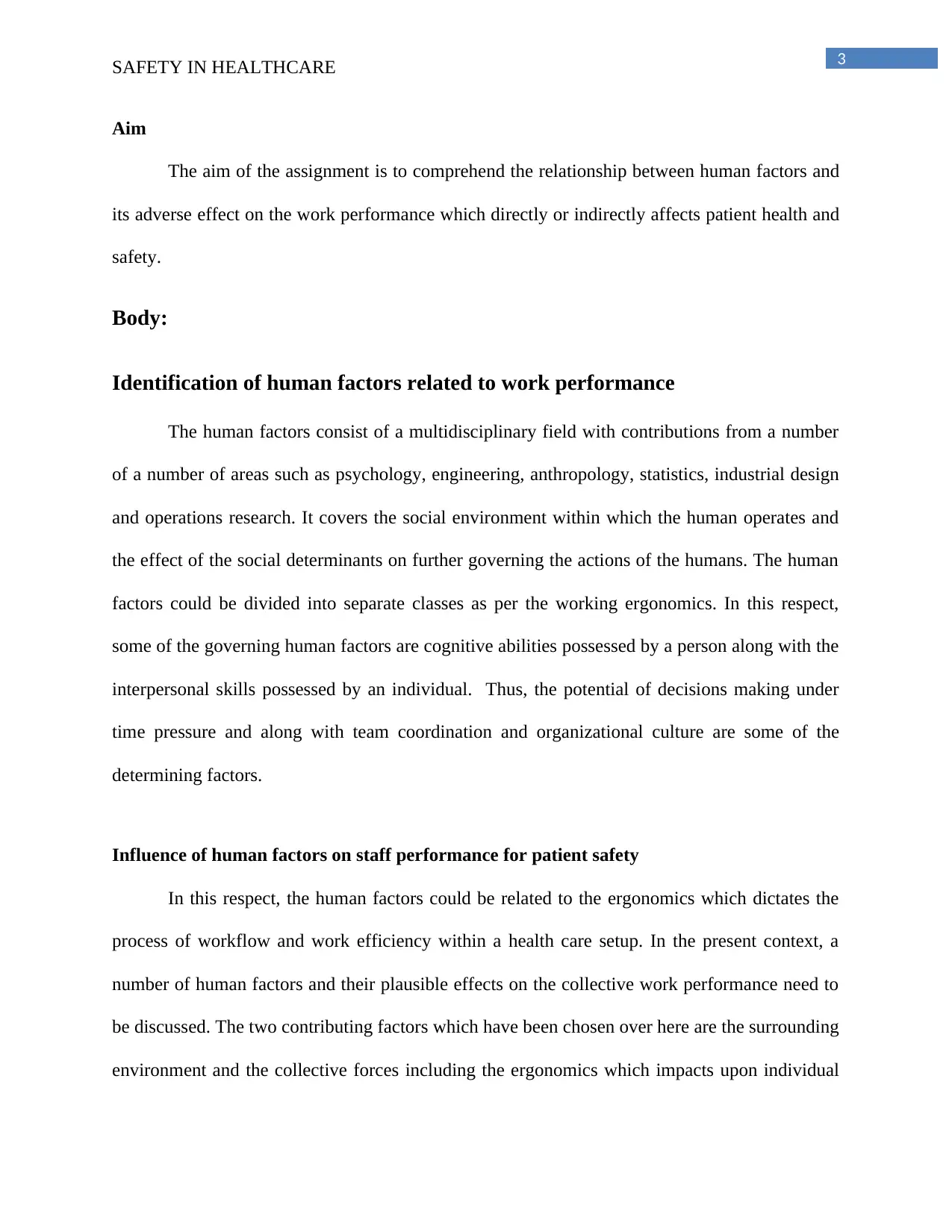
3SAFETY IN HEALTHCARE
Aim
The aim of the assignment is to comprehend the relationship between human factors and
its adverse effect on the work performance which directly or indirectly affects patient health and
safety.
Body:
Identification of human factors related to work performance
The human factors consist of a multidisciplinary field with contributions from a number
of a number of areas such as psychology, engineering, anthropology, statistics, industrial design
and operations research. It covers the social environment within which the human operates and
the effect of the social determinants on further governing the actions of the humans. The human
factors could be divided into separate classes as per the working ergonomics. In this respect,
some of the governing human factors are cognitive abilities possessed by a person along with the
interpersonal skills possessed by an individual. Thus, the potential of decisions making under
time pressure and along with team coordination and organizational culture are some of the
determining factors.
Influence of human factors on staff performance for patient safety
In this respect, the human factors could be related to the ergonomics which dictates the
process of workflow and work efficiency within a health care setup. In the present context, a
number of human factors and their plausible effects on the collective work performance need to
be discussed. The two contributing factors which have been chosen over here are the surrounding
environment and the collective forces including the ergonomics which impacts upon individual
Aim
The aim of the assignment is to comprehend the relationship between human factors and
its adverse effect on the work performance which directly or indirectly affects patient health and
safety.
Body:
Identification of human factors related to work performance
The human factors consist of a multidisciplinary field with contributions from a number
of a number of areas such as psychology, engineering, anthropology, statistics, industrial design
and operations research. It covers the social environment within which the human operates and
the effect of the social determinants on further governing the actions of the humans. The human
factors could be divided into separate classes as per the working ergonomics. In this respect,
some of the governing human factors are cognitive abilities possessed by a person along with the
interpersonal skills possessed by an individual. Thus, the potential of decisions making under
time pressure and along with team coordination and organizational culture are some of the
determining factors.
Influence of human factors on staff performance for patient safety
In this respect, the human factors could be related to the ergonomics which dictates the
process of workflow and work efficiency within a health care setup. In the present context, a
number of human factors and their plausible effects on the collective work performance need to
be discussed. The two contributing factors which have been chosen over here are the surrounding
environment and the collective forces including the ergonomics which impacts upon individual
Paraphrase This Document
Need a fresh take? Get an instant paraphrase of this document with our AI Paraphraser
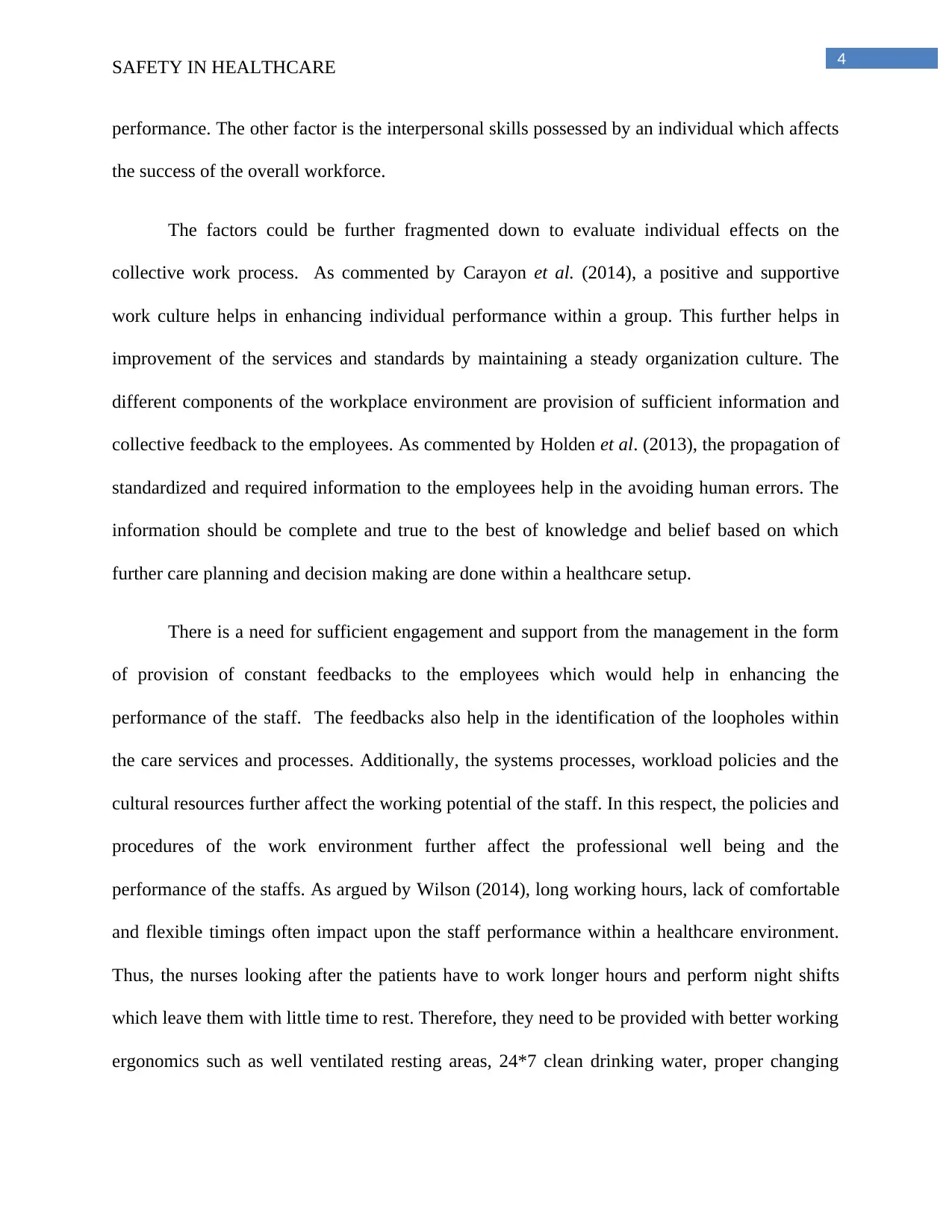
4SAFETY IN HEALTHCARE
performance. The other factor is the interpersonal skills possessed by an individual which affects
the success of the overall workforce.
The factors could be further fragmented down to evaluate individual effects on the
collective work process. As commented by Carayon et al. (2014), a positive and supportive
work culture helps in enhancing individual performance within a group. This further helps in
improvement of the services and standards by maintaining a steady organization culture. The
different components of the workplace environment are provision of sufficient information and
collective feedback to the employees. As commented by Holden et al. (2013), the propagation of
standardized and required information to the employees help in the avoiding human errors. The
information should be complete and true to the best of knowledge and belief based on which
further care planning and decision making are done within a healthcare setup.
There is a need for sufficient engagement and support from the management in the form
of provision of constant feedbacks to the employees which would help in enhancing the
performance of the staff. The feedbacks also help in the identification of the loopholes within
the care services and processes. Additionally, the systems processes, workload policies and the
cultural resources further affect the working potential of the staff. In this respect, the policies and
procedures of the work environment further affect the professional well being and the
performance of the staffs. As argued by Wilson (2014), long working hours, lack of comfortable
and flexible timings often impact upon the staff performance within a healthcare environment.
Thus, the nurses looking after the patients have to work longer hours and perform night shifts
which leave them with little time to rest. Therefore, they need to be provided with better working
ergonomics such as well ventilated resting areas, 24*7 clean drinking water, proper changing
performance. The other factor is the interpersonal skills possessed by an individual which affects
the success of the overall workforce.
The factors could be further fragmented down to evaluate individual effects on the
collective work process. As commented by Carayon et al. (2014), a positive and supportive
work culture helps in enhancing individual performance within a group. This further helps in
improvement of the services and standards by maintaining a steady organization culture. The
different components of the workplace environment are provision of sufficient information and
collective feedback to the employees. As commented by Holden et al. (2013), the propagation of
standardized and required information to the employees help in the avoiding human errors. The
information should be complete and true to the best of knowledge and belief based on which
further care planning and decision making are done within a healthcare setup.
There is a need for sufficient engagement and support from the management in the form
of provision of constant feedbacks to the employees which would help in enhancing the
performance of the staff. The feedbacks also help in the identification of the loopholes within
the care services and processes. Additionally, the systems processes, workload policies and the
cultural resources further affect the working potential of the staff. In this respect, the policies and
procedures of the work environment further affect the professional well being and the
performance of the staffs. As argued by Wilson (2014), long working hours, lack of comfortable
and flexible timings often impact upon the staff performance within a healthcare environment.
Thus, the nurses looking after the patients have to work longer hours and perform night shifts
which leave them with little time to rest. Therefore, they need to be provided with better working
ergonomics such as well ventilated resting areas, 24*7 clean drinking water, proper changing
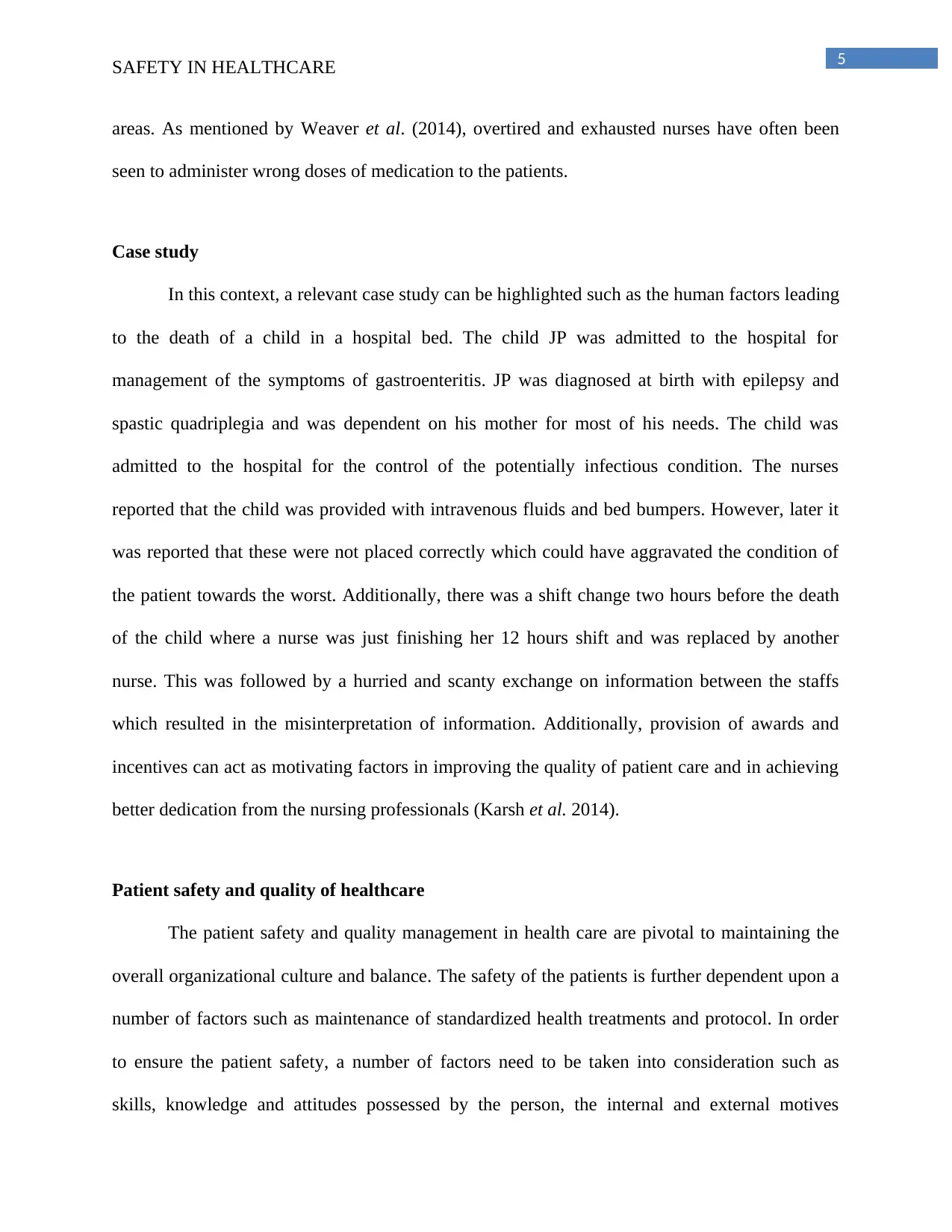
5SAFETY IN HEALTHCARE
areas. As mentioned by Weaver et al. (2014), overtired and exhausted nurses have often been
seen to administer wrong doses of medication to the patients.
Case study
In this context, a relevant case study can be highlighted such as the human factors leading
to the death of a child in a hospital bed. The child JP was admitted to the hospital for
management of the symptoms of gastroenteritis. JP was diagnosed at birth with epilepsy and
spastic quadriplegia and was dependent on his mother for most of his needs. The child was
admitted to the hospital for the control of the potentially infectious condition. The nurses
reported that the child was provided with intravenous fluids and bed bumpers. However, later it
was reported that these were not placed correctly which could have aggravated the condition of
the patient towards the worst. Additionally, there was a shift change two hours before the death
of the child where a nurse was just finishing her 12 hours shift and was replaced by another
nurse. This was followed by a hurried and scanty exchange on information between the staffs
which resulted in the misinterpretation of information. Additionally, provision of awards and
incentives can act as motivating factors in improving the quality of patient care and in achieving
better dedication from the nursing professionals (Karsh et al. 2014).
Patient safety and quality of healthcare
The patient safety and quality management in health care are pivotal to maintaining the
overall organizational culture and balance. The safety of the patients is further dependent upon a
number of factors such as maintenance of standardized health treatments and protocol. In order
to ensure the patient safety, a number of factors need to be taken into consideration such as
skills, knowledge and attitudes possessed by the person, the internal and external motives
areas. As mentioned by Weaver et al. (2014), overtired and exhausted nurses have often been
seen to administer wrong doses of medication to the patients.
Case study
In this context, a relevant case study can be highlighted such as the human factors leading
to the death of a child in a hospital bed. The child JP was admitted to the hospital for
management of the symptoms of gastroenteritis. JP was diagnosed at birth with epilepsy and
spastic quadriplegia and was dependent on his mother for most of his needs. The child was
admitted to the hospital for the control of the potentially infectious condition. The nurses
reported that the child was provided with intravenous fluids and bed bumpers. However, later it
was reported that these were not placed correctly which could have aggravated the condition of
the patient towards the worst. Additionally, there was a shift change two hours before the death
of the child where a nurse was just finishing her 12 hours shift and was replaced by another
nurse. This was followed by a hurried and scanty exchange on information between the staffs
which resulted in the misinterpretation of information. Additionally, provision of awards and
incentives can act as motivating factors in improving the quality of patient care and in achieving
better dedication from the nursing professionals (Karsh et al. 2014).
Patient safety and quality of healthcare
The patient safety and quality management in health care are pivotal to maintaining the
overall organizational culture and balance. The safety of the patients is further dependent upon a
number of factors such as maintenance of standardized health treatments and protocol. In order
to ensure the patient safety, a number of factors need to be taken into consideration such as
skills, knowledge and attitudes possessed by the person, the internal and external motives
⊘ This is a preview!⊘
Do you want full access?
Subscribe today to unlock all pages.

Trusted by 1+ million students worldwide
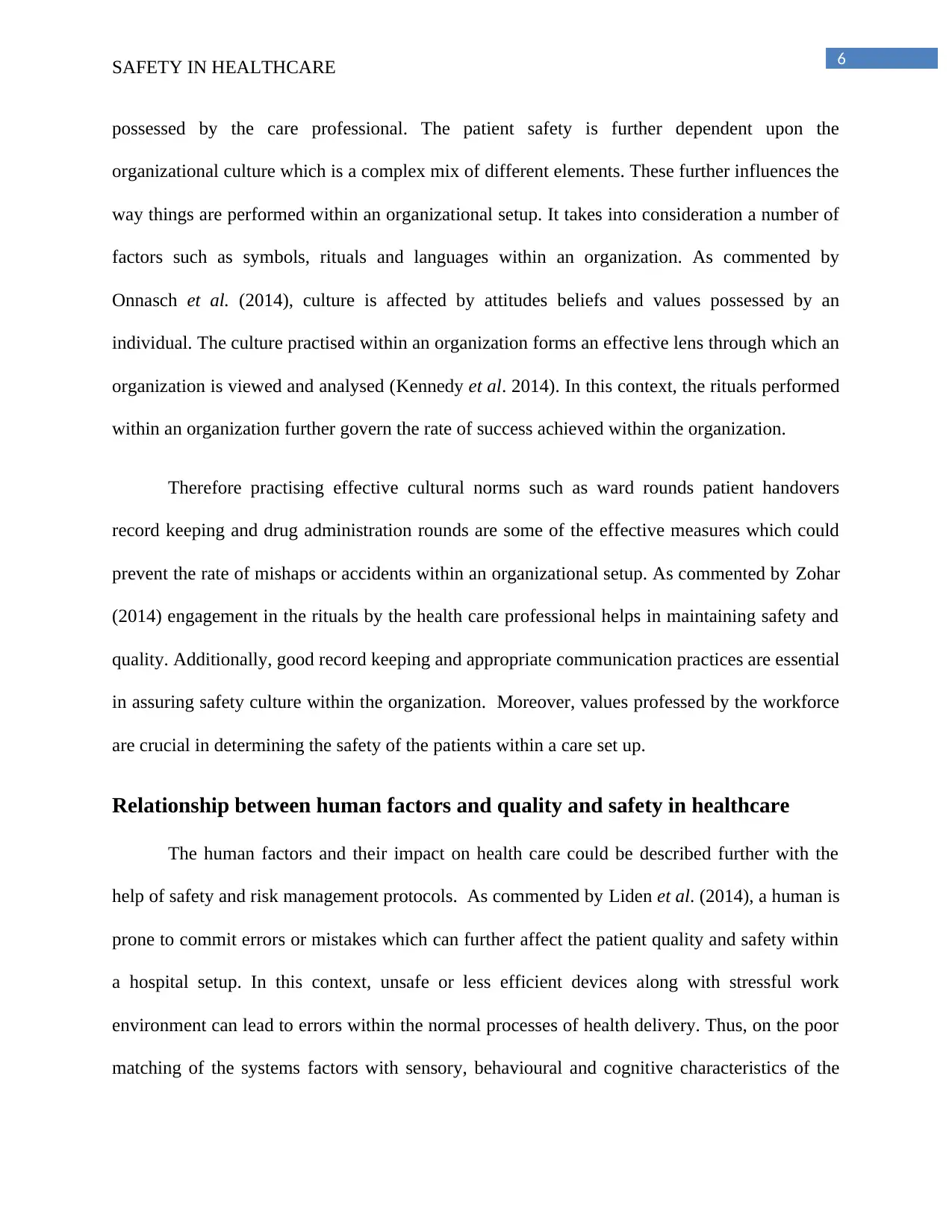
6SAFETY IN HEALTHCARE
possessed by the care professional. The patient safety is further dependent upon the
organizational culture which is a complex mix of different elements. These further influences the
way things are performed within an organizational setup. It takes into consideration a number of
factors such as symbols, rituals and languages within an organization. As commented by
Onnasch et al. (2014), culture is affected by attitudes beliefs and values possessed by an
individual. The culture practised within an organization forms an effective lens through which an
organization is viewed and analysed (Kennedy et al. 2014). In this context, the rituals performed
within an organization further govern the rate of success achieved within the organization.
Therefore practising effective cultural norms such as ward rounds patient handovers
record keeping and drug administration rounds are some of the effective measures which could
prevent the rate of mishaps or accidents within an organizational setup. As commented by Zohar
(2014) engagement in the rituals by the health care professional helps in maintaining safety and
quality. Additionally, good record keeping and appropriate communication practices are essential
in assuring safety culture within the organization. Moreover, values professed by the workforce
are crucial in determining the safety of the patients within a care set up.
Relationship between human factors and quality and safety in healthcare
The human factors and their impact on health care could be described further with the
help of safety and risk management protocols. As commented by Liden et al. (2014), a human is
prone to commit errors or mistakes which can further affect the patient quality and safety within
a hospital setup. In this context, unsafe or less efficient devices along with stressful work
environment can lead to errors within the normal processes of health delivery. Thus, on the poor
matching of the systems factors with sensory, behavioural and cognitive characteristics of the
possessed by the care professional. The patient safety is further dependent upon the
organizational culture which is a complex mix of different elements. These further influences the
way things are performed within an organizational setup. It takes into consideration a number of
factors such as symbols, rituals and languages within an organization. As commented by
Onnasch et al. (2014), culture is affected by attitudes beliefs and values possessed by an
individual. The culture practised within an organization forms an effective lens through which an
organization is viewed and analysed (Kennedy et al. 2014). In this context, the rituals performed
within an organization further govern the rate of success achieved within the organization.
Therefore practising effective cultural norms such as ward rounds patient handovers
record keeping and drug administration rounds are some of the effective measures which could
prevent the rate of mishaps or accidents within an organizational setup. As commented by Zohar
(2014) engagement in the rituals by the health care professional helps in maintaining safety and
quality. Additionally, good record keeping and appropriate communication practices are essential
in assuring safety culture within the organization. Moreover, values professed by the workforce
are crucial in determining the safety of the patients within a care set up.
Relationship between human factors and quality and safety in healthcare
The human factors and their impact on health care could be described further with the
help of safety and risk management protocols. As commented by Liden et al. (2014), a human is
prone to commit errors or mistakes which can further affect the patient quality and safety within
a hospital setup. In this context, unsafe or less efficient devices along with stressful work
environment can lead to errors within the normal processes of health delivery. Thus, on the poor
matching of the systems factors with sensory, behavioural and cognitive characteristics of the
Paraphrase This Document
Need a fresh take? Get an instant paraphrase of this document with our AI Paraphraser
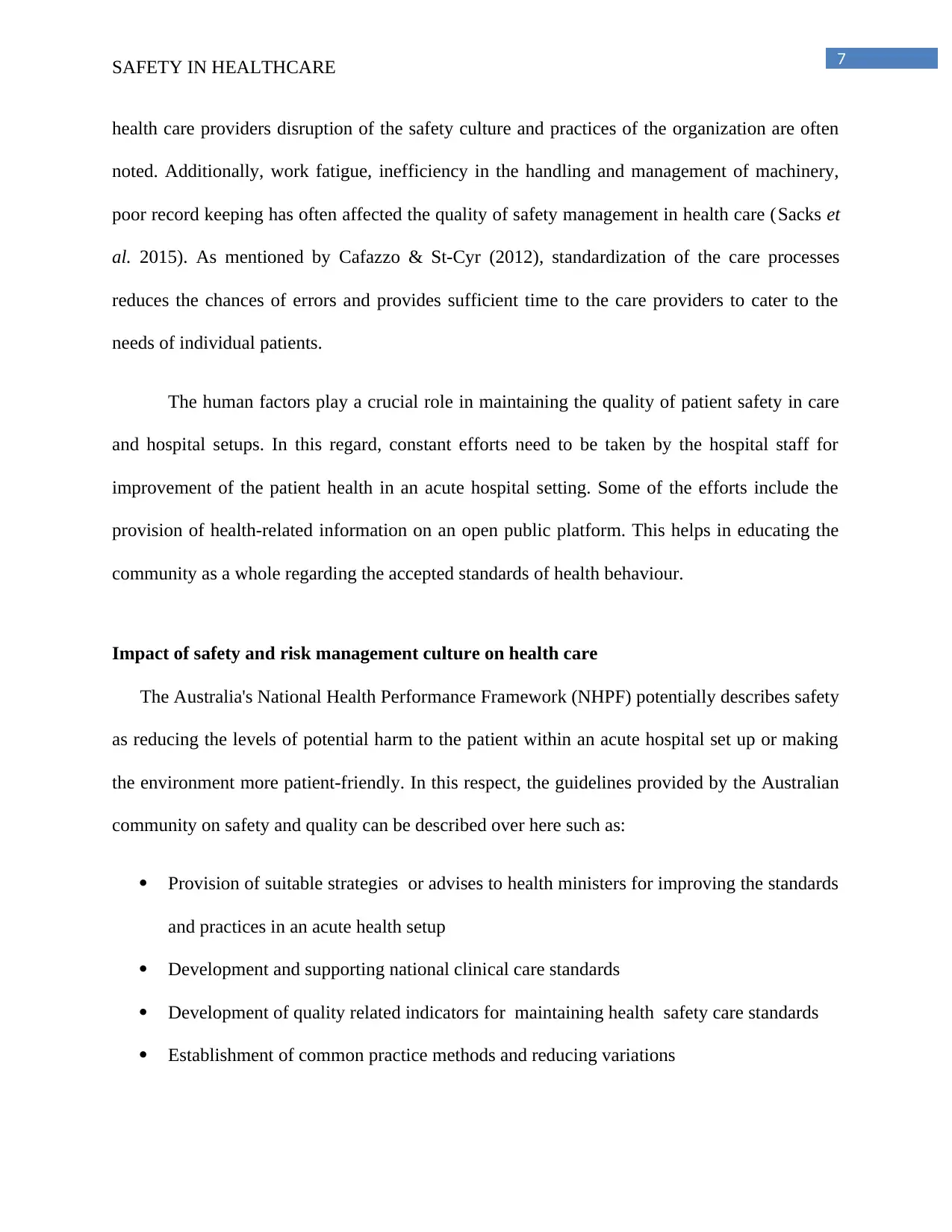
7SAFETY IN HEALTHCARE
health care providers disruption of the safety culture and practices of the organization are often
noted. Additionally, work fatigue, inefficiency in the handling and management of machinery,
poor record keeping has often affected the quality of safety management in health care (Sacks et
al. 2015). As mentioned by Cafazzo & St-Cyr (2012), standardization of the care processes
reduces the chances of errors and provides sufficient time to the care providers to cater to the
needs of individual patients.
The human factors play a crucial role in maintaining the quality of patient safety in care
and hospital setups. In this regard, constant efforts need to be taken by the hospital staff for
improvement of the patient health in an acute hospital setting. Some of the efforts include the
provision of health-related information on an open public platform. This helps in educating the
community as a whole regarding the accepted standards of health behaviour.
Impact of safety and risk management culture on health care
The Australia's National Health Performance Framework (NHPF) potentially describes safety
as reducing the levels of potential harm to the patient within an acute hospital set up or making
the environment more patient-friendly. In this respect, the guidelines provided by the Australian
community on safety and quality can be described over here such as:
Provision of suitable strategies or advises to health ministers for improving the standards
and practices in an acute health setup
Development and supporting national clinical care standards
Development of quality related indicators for maintaining health safety care standards
Establishment of common practice methods and reducing variations
health care providers disruption of the safety culture and practices of the organization are often
noted. Additionally, work fatigue, inefficiency in the handling and management of machinery,
poor record keeping has often affected the quality of safety management in health care (Sacks et
al. 2015). As mentioned by Cafazzo & St-Cyr (2012), standardization of the care processes
reduces the chances of errors and provides sufficient time to the care providers to cater to the
needs of individual patients.
The human factors play a crucial role in maintaining the quality of patient safety in care
and hospital setups. In this regard, constant efforts need to be taken by the hospital staff for
improvement of the patient health in an acute hospital setting. Some of the efforts include the
provision of health-related information on an open public platform. This helps in educating the
community as a whole regarding the accepted standards of health behaviour.
Impact of safety and risk management culture on health care
The Australia's National Health Performance Framework (NHPF) potentially describes safety
as reducing the levels of potential harm to the patient within an acute hospital set up or making
the environment more patient-friendly. In this respect, the guidelines provided by the Australian
community on safety and quality can be described over here such as:
Provision of suitable strategies or advises to health ministers for improving the standards
and practices in an acute health setup
Development and supporting national clinical care standards
Development of quality related indicators for maintaining health safety care standards
Establishment of common practice methods and reducing variations
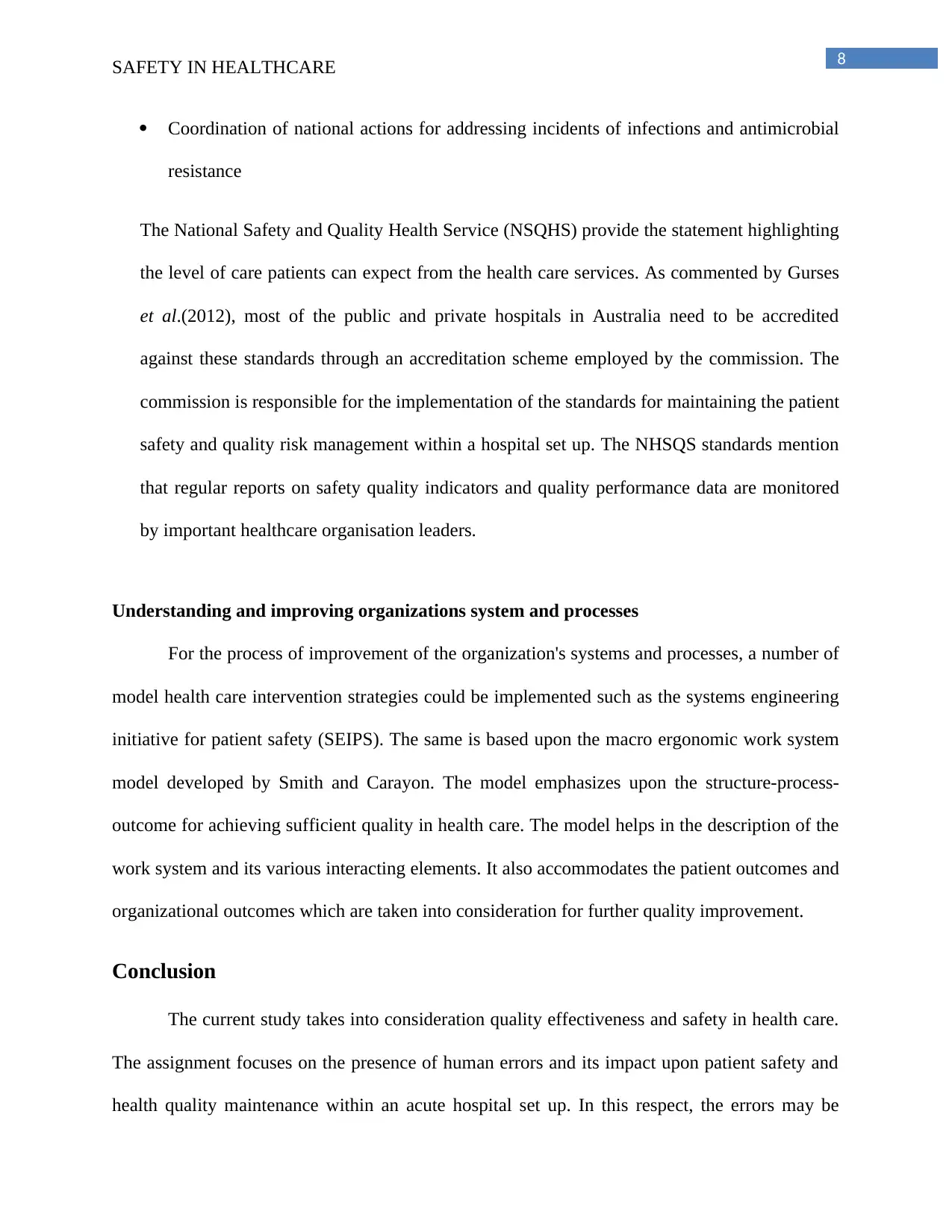
8SAFETY IN HEALTHCARE
Coordination of national actions for addressing incidents of infections and antimicrobial
resistance
The National Safety and Quality Health Service (NSQHS) provide the statement highlighting
the level of care patients can expect from the health care services. As commented by Gurses
et al.(2012), most of the public and private hospitals in Australia need to be accredited
against these standards through an accreditation scheme employed by the commission. The
commission is responsible for the implementation of the standards for maintaining the patient
safety and quality risk management within a hospital set up. The NHSQS standards mention
that regular reports on safety quality indicators and quality performance data are monitored
by important healthcare organisation leaders.
Understanding and improving organizations system and processes
For the process of improvement of the organization's systems and processes, a number of
model health care intervention strategies could be implemented such as the systems engineering
initiative for patient safety (SEIPS). The same is based upon the macro ergonomic work system
model developed by Smith and Carayon. The model emphasizes upon the structure-process-
outcome for achieving sufficient quality in health care. The model helps in the description of the
work system and its various interacting elements. It also accommodates the patient outcomes and
organizational outcomes which are taken into consideration for further quality improvement.
Conclusion
The current study takes into consideration quality effectiveness and safety in health care.
The assignment focuses on the presence of human errors and its impact upon patient safety and
health quality maintenance within an acute hospital set up. In this respect, the errors may be
Coordination of national actions for addressing incidents of infections and antimicrobial
resistance
The National Safety and Quality Health Service (NSQHS) provide the statement highlighting
the level of care patients can expect from the health care services. As commented by Gurses
et al.(2012), most of the public and private hospitals in Australia need to be accredited
against these standards through an accreditation scheme employed by the commission. The
commission is responsible for the implementation of the standards for maintaining the patient
safety and quality risk management within a hospital set up. The NHSQS standards mention
that regular reports on safety quality indicators and quality performance data are monitored
by important healthcare organisation leaders.
Understanding and improving organizations system and processes
For the process of improvement of the organization's systems and processes, a number of
model health care intervention strategies could be implemented such as the systems engineering
initiative for patient safety (SEIPS). The same is based upon the macro ergonomic work system
model developed by Smith and Carayon. The model emphasizes upon the structure-process-
outcome for achieving sufficient quality in health care. The model helps in the description of the
work system and its various interacting elements. It also accommodates the patient outcomes and
organizational outcomes which are taken into consideration for further quality improvement.
Conclusion
The current study takes into consideration quality effectiveness and safety in health care.
The assignment focuses on the presence of human errors and its impact upon patient safety and
health quality maintenance within an acute hospital set up. In this respect, the errors may be
⊘ This is a preview!⊘
Do you want full access?
Subscribe today to unlock all pages.

Trusted by 1+ million students worldwide
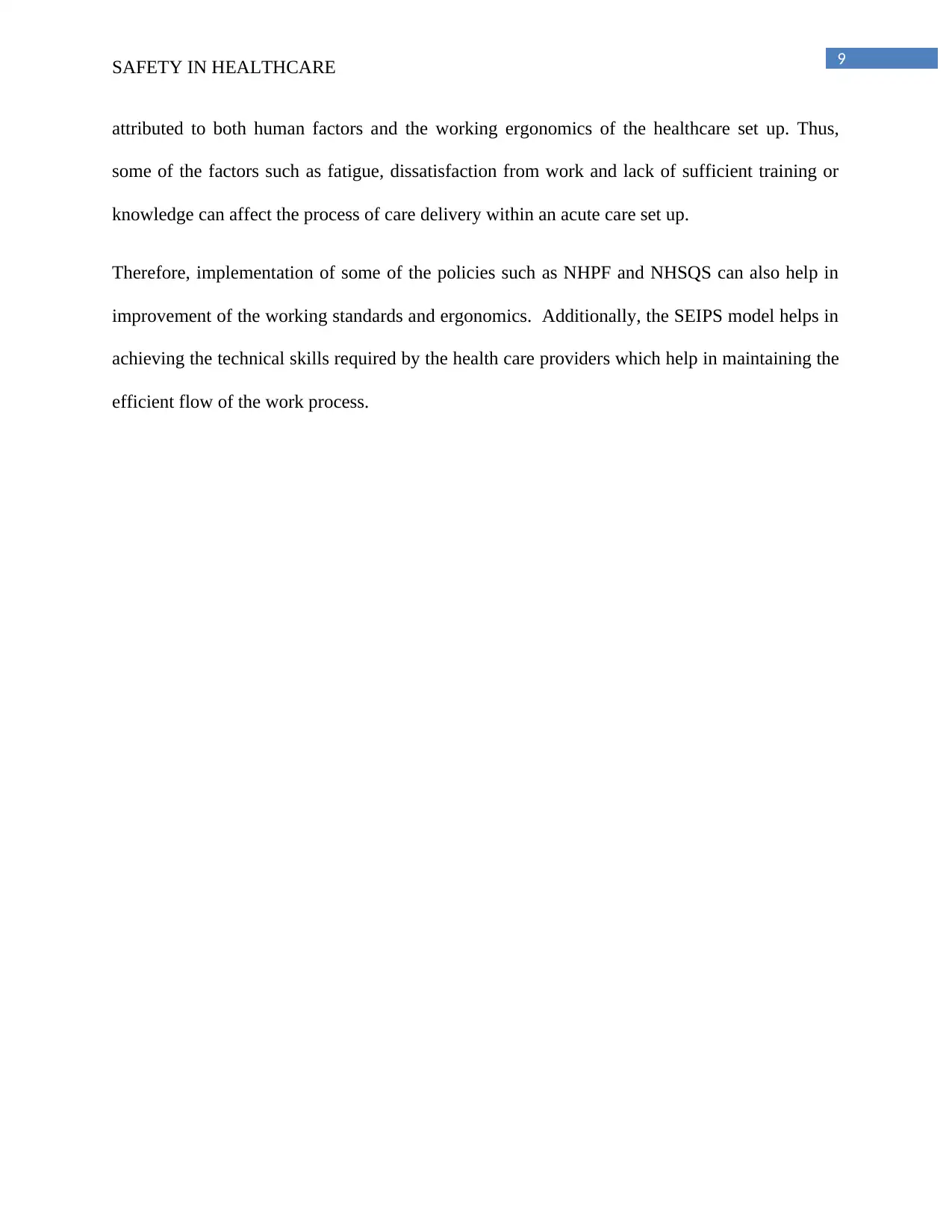
9SAFETY IN HEALTHCARE
attributed to both human factors and the working ergonomics of the healthcare set up. Thus,
some of the factors such as fatigue, dissatisfaction from work and lack of sufficient training or
knowledge can affect the process of care delivery within an acute care set up.
Therefore, implementation of some of the policies such as NHPF and NHSQS can also help in
improvement of the working standards and ergonomics. Additionally, the SEIPS model helps in
achieving the technical skills required by the health care providers which help in maintaining the
efficient flow of the work process.
attributed to both human factors and the working ergonomics of the healthcare set up. Thus,
some of the factors such as fatigue, dissatisfaction from work and lack of sufficient training or
knowledge can affect the process of care delivery within an acute care set up.
Therefore, implementation of some of the policies such as NHPF and NHSQS can also help in
improvement of the working standards and ergonomics. Additionally, the SEIPS model helps in
achieving the technical skills required by the health care providers which help in maintaining the
efficient flow of the work process.
Paraphrase This Document
Need a fresh take? Get an instant paraphrase of this document with our AI Paraphraser
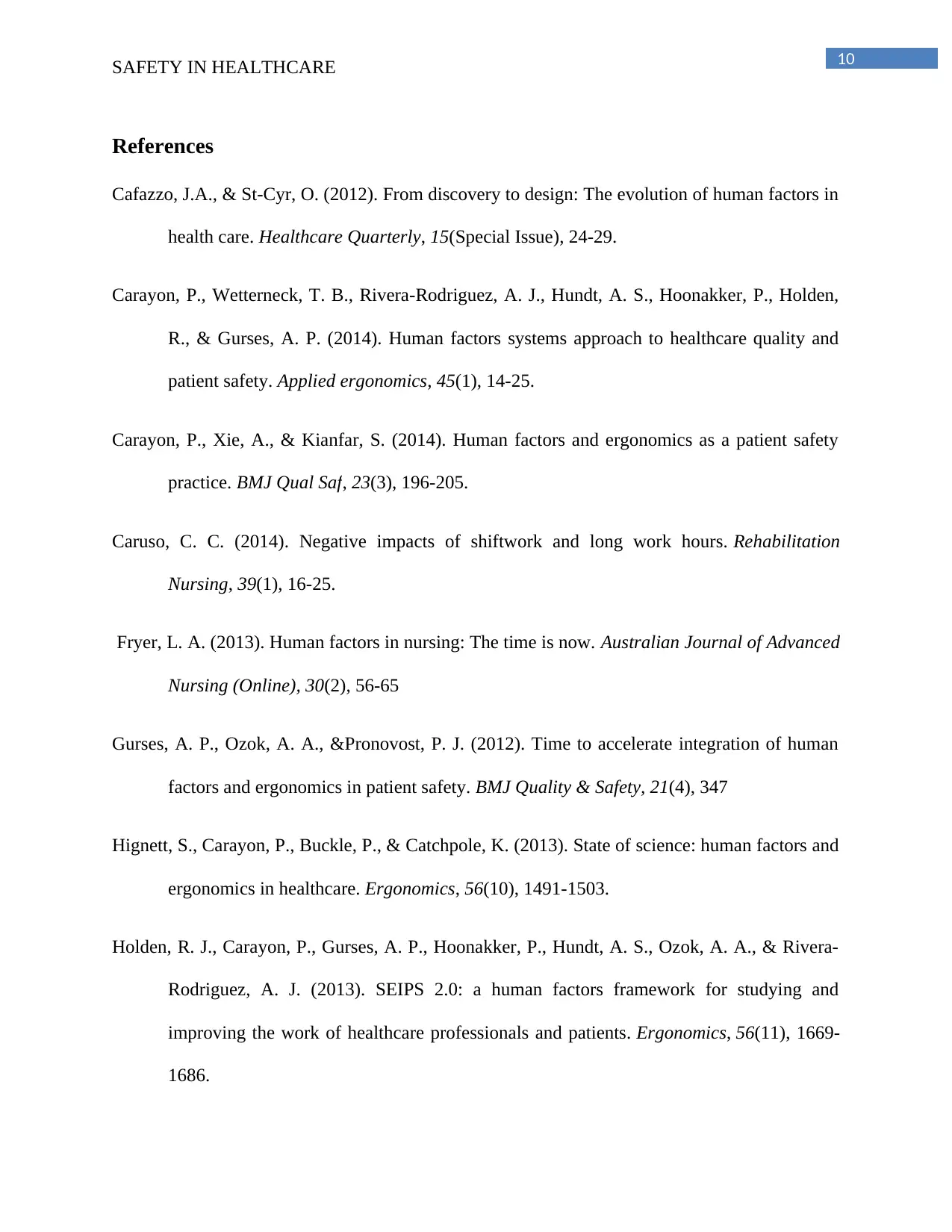
10SAFETY IN HEALTHCARE
References
Cafazzo, J.A., & St-Cyr, O. (2012). From discovery to design: The evolution of human factors in
health care. Healthcare Quarterly, 15(Special Issue), 24-29.
Carayon, P., Wetterneck, T. B., Rivera-Rodriguez, A. J., Hundt, A. S., Hoonakker, P., Holden,
R., & Gurses, A. P. (2014). Human factors systems approach to healthcare quality and
patient safety. Applied ergonomics, 45(1), 14-25.
Carayon, P., Xie, A., & Kianfar, S. (2014). Human factors and ergonomics as a patient safety
practice. BMJ Qual Saf, 23(3), 196-205.
Caruso, C. C. (2014). Negative impacts of shiftwork and long work hours. Rehabilitation
Nursing, 39(1), 16-25.
Fryer, L. A. (2013). Human factors in nursing: The time is now. Australian Journal of Advanced
Nursing (Online), 30(2), 56-65
Gurses, A. P., Ozok, A. A., &Pronovost, P. J. (2012). Time to accelerate integration of human
factors and ergonomics in patient safety. BMJ Quality & Safety, 21(4), 347
Hignett, S., Carayon, P., Buckle, P., & Catchpole, K. (2013). State of science: human factors and
ergonomics in healthcare. Ergonomics, 56(10), 1491-1503.
Holden, R. J., Carayon, P., Gurses, A. P., Hoonakker, P., Hundt, A. S., Ozok, A. A., & Rivera-
Rodriguez, A. J. (2013). SEIPS 2.0: a human factors framework for studying and
improving the work of healthcare professionals and patients. Ergonomics, 56(11), 1669-
1686.
References
Cafazzo, J.A., & St-Cyr, O. (2012). From discovery to design: The evolution of human factors in
health care. Healthcare Quarterly, 15(Special Issue), 24-29.
Carayon, P., Wetterneck, T. B., Rivera-Rodriguez, A. J., Hundt, A. S., Hoonakker, P., Holden,
R., & Gurses, A. P. (2014). Human factors systems approach to healthcare quality and
patient safety. Applied ergonomics, 45(1), 14-25.
Carayon, P., Xie, A., & Kianfar, S. (2014). Human factors and ergonomics as a patient safety
practice. BMJ Qual Saf, 23(3), 196-205.
Caruso, C. C. (2014). Negative impacts of shiftwork and long work hours. Rehabilitation
Nursing, 39(1), 16-25.
Fryer, L. A. (2013). Human factors in nursing: The time is now. Australian Journal of Advanced
Nursing (Online), 30(2), 56-65
Gurses, A. P., Ozok, A. A., &Pronovost, P. J. (2012). Time to accelerate integration of human
factors and ergonomics in patient safety. BMJ Quality & Safety, 21(4), 347
Hignett, S., Carayon, P., Buckle, P., & Catchpole, K. (2013). State of science: human factors and
ergonomics in healthcare. Ergonomics, 56(10), 1491-1503.
Holden, R. J., Carayon, P., Gurses, A. P., Hoonakker, P., Hundt, A. S., Ozok, A. A., & Rivera-
Rodriguez, A. J. (2013). SEIPS 2.0: a human factors framework for studying and
improving the work of healthcare professionals and patients. Ergonomics, 56(11), 1669-
1686.
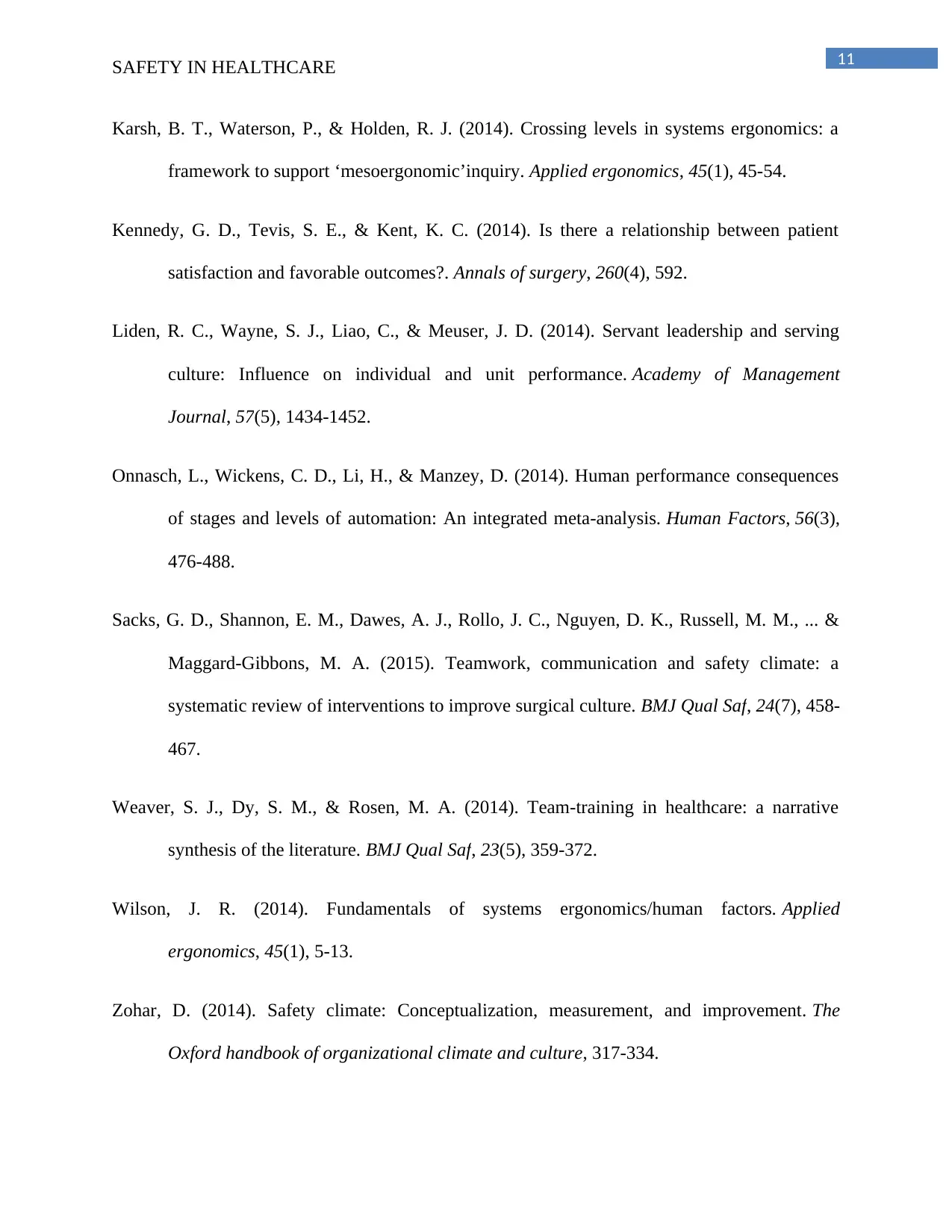
11SAFETY IN HEALTHCARE
Karsh, B. T., Waterson, P., & Holden, R. J. (2014). Crossing levels in systems ergonomics: a
framework to support ‘mesoergonomic’inquiry. Applied ergonomics, 45(1), 45-54.
Kennedy, G. D., Tevis, S. E., & Kent, K. C. (2014). Is there a relationship between patient
satisfaction and favorable outcomes?. Annals of surgery, 260(4), 592.
Liden, R. C., Wayne, S. J., Liao, C., & Meuser, J. D. (2014). Servant leadership and serving
culture: Influence on individual and unit performance. Academy of Management
Journal, 57(5), 1434-1452.
Onnasch, L., Wickens, C. D., Li, H., & Manzey, D. (2014). Human performance consequences
of stages and levels of automation: An integrated meta-analysis. Human Factors, 56(3),
476-488.
Sacks, G. D., Shannon, E. M., Dawes, A. J., Rollo, J. C., Nguyen, D. K., Russell, M. M., ... &
Maggard-Gibbons, M. A. (2015). Teamwork, communication and safety climate: a
systematic review of interventions to improve surgical culture. BMJ Qual Saf, 24(7), 458-
467.
Weaver, S. J., Dy, S. M., & Rosen, M. A. (2014). Team-training in healthcare: a narrative
synthesis of the literature. BMJ Qual Saf, 23(5), 359-372.
Wilson, J. R. (2014). Fundamentals of systems ergonomics/human factors. Applied
ergonomics, 45(1), 5-13.
Zohar, D. (2014). Safety climate: Conceptualization, measurement, and improvement. The
Oxford handbook of organizational climate and culture, 317-334.
Karsh, B. T., Waterson, P., & Holden, R. J. (2014). Crossing levels in systems ergonomics: a
framework to support ‘mesoergonomic’inquiry. Applied ergonomics, 45(1), 45-54.
Kennedy, G. D., Tevis, S. E., & Kent, K. C. (2014). Is there a relationship between patient
satisfaction and favorable outcomes?. Annals of surgery, 260(4), 592.
Liden, R. C., Wayne, S. J., Liao, C., & Meuser, J. D. (2014). Servant leadership and serving
culture: Influence on individual and unit performance. Academy of Management
Journal, 57(5), 1434-1452.
Onnasch, L., Wickens, C. D., Li, H., & Manzey, D. (2014). Human performance consequences
of stages and levels of automation: An integrated meta-analysis. Human Factors, 56(3),
476-488.
Sacks, G. D., Shannon, E. M., Dawes, A. J., Rollo, J. C., Nguyen, D. K., Russell, M. M., ... &
Maggard-Gibbons, M. A. (2015). Teamwork, communication and safety climate: a
systematic review of interventions to improve surgical culture. BMJ Qual Saf, 24(7), 458-
467.
Weaver, S. J., Dy, S. M., & Rosen, M. A. (2014). Team-training in healthcare: a narrative
synthesis of the literature. BMJ Qual Saf, 23(5), 359-372.
Wilson, J. R. (2014). Fundamentals of systems ergonomics/human factors. Applied
ergonomics, 45(1), 5-13.
Zohar, D. (2014). Safety climate: Conceptualization, measurement, and improvement. The
Oxford handbook of organizational climate and culture, 317-334.
⊘ This is a preview!⊘
Do you want full access?
Subscribe today to unlock all pages.

Trusted by 1+ million students worldwide
1 out of 13
Related Documents
Your All-in-One AI-Powered Toolkit for Academic Success.
+13062052269
info@desklib.com
Available 24*7 on WhatsApp / Email
![[object Object]](/_next/static/media/star-bottom.7253800d.svg)
Unlock your academic potential
Copyright © 2020–2025 A2Z Services. All Rights Reserved. Developed and managed by ZUCOL.




